
A view from the Louvre Abu Dhabi designed by Jean Nouvel where the light constantly plays with the shades
The stopover in Abu Dhabi on my way to Auckland, NZ, was only prompted by the tempting offer made by Etihad Airways to stay for a few nights. Well not only actually, since my nephew and his wife live there and they had for a long time extended an invitation to come and visit. And of course, there was also the Louvre Abu Dhabi, of which I had seen so many photoghaphs. Well, as always, my stay there was very different from what I expected, just much better and completely enlightening. The nice Ugandan chauffeur Yacine met me at the airport and immediately conveyed a feel of luxury and kindness. A delicious dinner awaited me all provided by Waitrose and wine flowed. Nothing like what I remembered from Saudi Arabia in the 1980’s…

Philippe Béhagle, Embarkation fo teh Emperor of CHina, Manufacture Royale de Beauvais, France, about 1700, Louvre Abu Dhabi
My first move was to go and visit the Louvre, a short distance from the Four Seasons Hotel and the Corniche where some of the government offices are. The first impression is that you never see the museum from the outside. YOU can’t approach it from the sea. What a disappointment. But the circulation inside, is that of an elegant mall where you meet visitors under the dome which protects you from the sun and where light filters with great parsimony. I enjoyed going back and forth for a few hours.
One gets a little lost at first, and I started by chance with the children’s gallery where I registered as Laure, 10 years old, to get a bracelet with a bar code which would entitle me to get explanations on everything. A great place and fun to play but too dark…
What is not fascinating at all is the interaction between the lighting system and the vitrines. These exceptional objects are impossible to see most of the time because of reflections. I was very irritated at first. But the following galleries of tapestries and large sculptures lent by Versailles and the Louvre, are so stunning that I regained my enthusiasm.
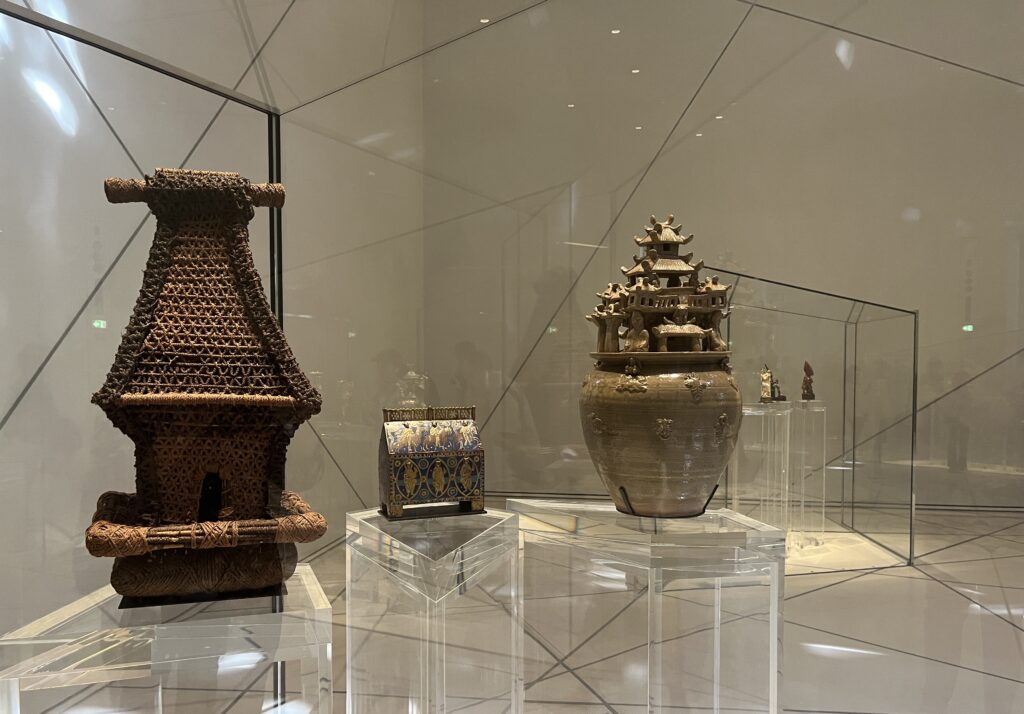
Portable Temple, Oceania Fiji, before 1900, Funerary jar, Louvre Abu Dhabi, Western Jin Dynasty, China Sichuan, 265-316 CE, Musée National Guimet, reliquary casket, France Limoges, about 1200, Louvre Abu Dhabi, all items are hard to see because of the reflections in the vitrines
The circulation of the galleries is quite good especially since it was Chinese New Year and there were already large groups of visitors at 11 am. I loved that there was a portrait of George Washington by Gilbert Stuart and a ravishing gouache by Jean-Etienne Liotard, the Swiss painter I admire. Also a beautiful Chagall “Between Darkness and night” painted during the war between Paris and New York. The paneled room designed by Jacques Emile Ruhlmann for Lord Rothermere and the Cy Twombly blue room with fragments of 2000 BCE stones from Saudi Arabia end the visit in great style. Sadly the XX th century paintings room floats without a direction.
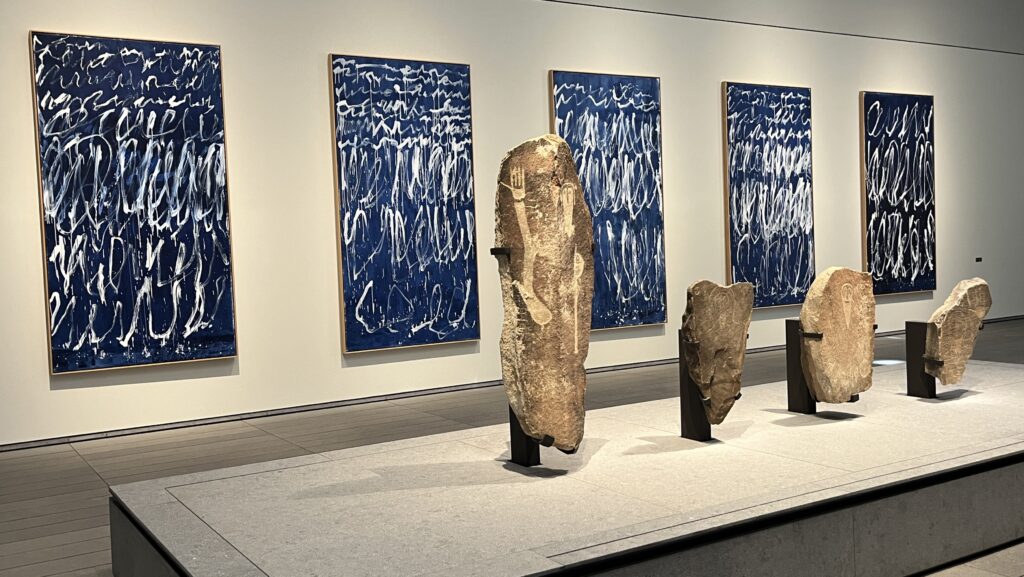
Fragments of rocks from Sarat Abidah in Saudi Arabia, 2000 BCE are displayed among the Cy Twombly “Untitled I-IX”, series of 9 panels , Louvre Abu Dhabi
In the adjacent courtyards ART HERE 2023 was showing the works of a few Kuwaiti, Saudi and UAE artists who were all interesting. And of course I loved Jenny Holzer’s various inscriptions on glass and marble commissioned especially for the museum. Giuseppe Penone’s four works in terracotta, porcelain and bronze emerge in the main space under the Jean Nouvel dome. The visit takes approximately 3 hours and you can extend it with lunch at the café or at Fouquet’s, the fancy restaurant on the water. I preferred the Em Sherif café on the Corniche with superb Lebanese food and the beach as a decor.
But the adventure did not end there. We visited the Grand Sheikh Zayed Grand Mosque (from he outside only because I had forgotten my abaya), which is 290 m X 420 m long. And the Presidential Palace Qasr Al Watan, a 380 000 square meter complex, which took 7 years to build (2010-2017). The square in front of the palace irrestibly reminded me of the Place Saint Pierre at the Vatican. It is as large. Both buildings are worth seeing for the large scale and Syrian or Indian stone work and mosaics.
On the way back south to Abu Dhabi (2 hrs) we stopped to see the galleries of Dubai where I liked the Iranian painter Pouran Jinchi’s « Fly like dandelions » paintings.
There were more visits on Sunday when it miraculously rained a little bit and it was announced that schools would be closed on Monday due to weather conditions. The children’s library with a brand new Alain Ducasse cooking school and the visit of the Abrahamic family house designed by Ghanean architect David Adjaye and inaugurated a year ago in February. With its Imam Al-Tayeb mosque, its Moses Ben Maimon synagogue and St Francis church, the center stands very near the Louvre and the future Guggenheim museum designed by Frank Gehry and due to open in 2026. It is not only beautiful with its buildings lit up by the sun, it also reflects the Intereligious dialogue wanted by the Emirati.

The Guggenheim museum should be finished in 2026, on Saadiyadt island where all the museums stand and more and more trendy young families move to live
On my way to the superb airport designed by KPF, I received persistent noisy alert text messages telling me to slow down on the motorway due to light rain. I suddenly realized I was under constant supervision since I arrived, and the airport echoed all the other phone alerts…. it was only drizzling of course. How weird.
Share this Post
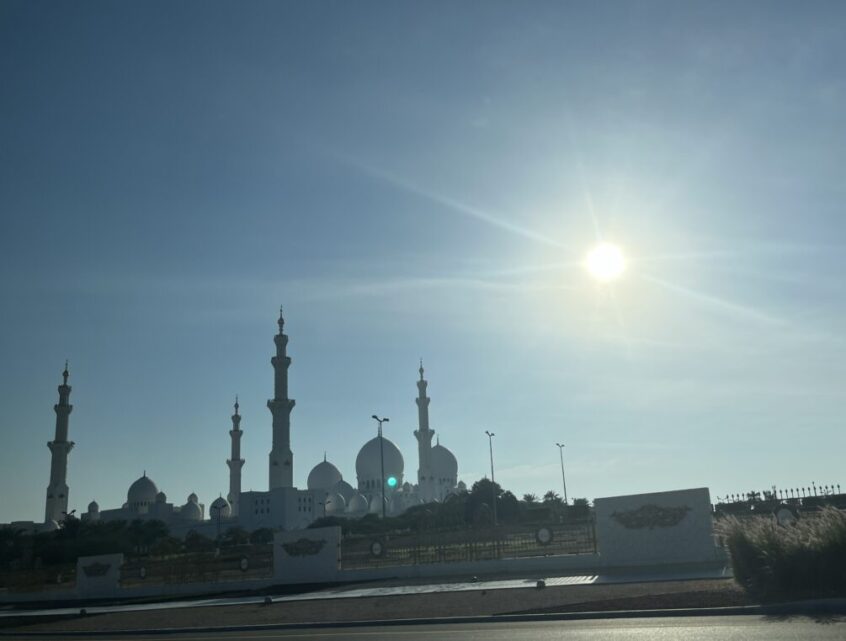
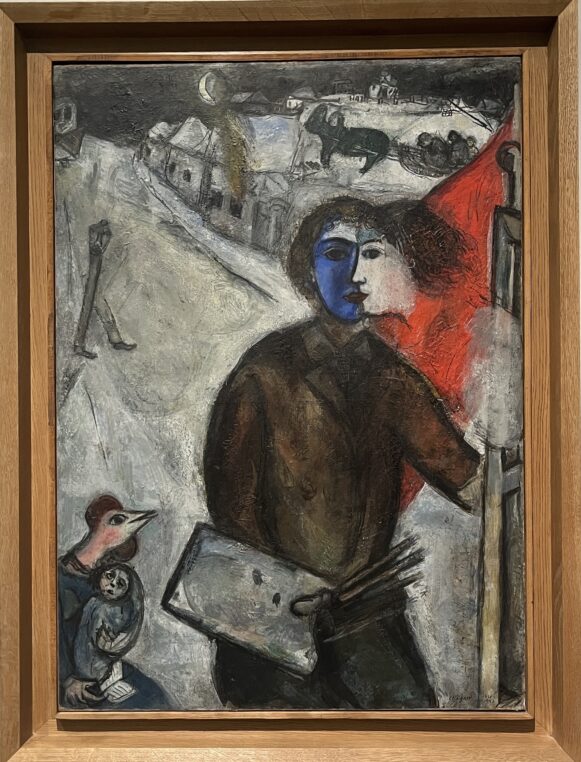
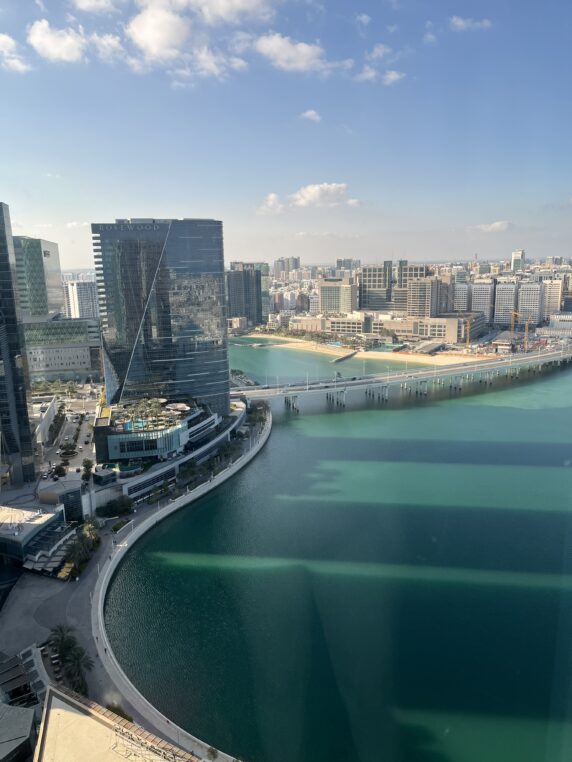






2 Comments on “Abu Dhabi is an emirate to discover”
What a fascinating and informative account of your trip to Abu Dhabi! Must put on my list of places to visit
Want to go there now! Fabulous.